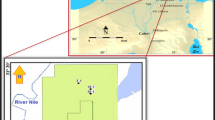Abstract
Demand for commercial energy of Thailand has continuously increased and proved reserves (P1) of natural gas will be consumed within only next 11 years. If there are additional data of exploration and drilling, probable (P2) and possible (P3) reserves including undiscovered total petroleum initially in place (PIIP) could be developed to P1 and will last a further 30 years. One area with high potential is the Huai Hin Lat Formation, Sap Phlu Basin, that the Khlong Muang section was studied. It is 29 m thick correlating to a part of the Sam Khaen Conglomerate Member and was divided into under 2, 2–4, and over 4 cm pebble sizes. Six samples were measured their matrix area percentage by using planimeter, rock mechanical properties following ASTM D7012-14, and rock-forming elements and minerals obtained by XRF and XRD methods. The matrix areas range from 1.47 to 24.88% of smaller- to larger-grained samples. Conformably, grain and matrix are composed of calcite and quartz of brittle minerals that are easily fractured or rephrased with compressive strength of around 78 MPa. Moreover, Al2O3 was detected that probably belongs to clay minerals and gradually increases from smaller- to larger-grained samples. As a result, Young’s modulus, Poisson’s ratio, and compressive strength of Beds 20 and 24 and Beds 4 and 18 are the lowest (5.48 MPa, 0.115, and 41.41 MPa) and the highest (11.69 MPa, 0.172, and 69.16 MPa). Therefore, rock mechanical properties are associated with rock-forming minerals of grain and matrix as well as their area percentages.




Similar content being viewed by others
References
American Society for Testing and Materials (2014) Standard test methods for compressive strength and elastic moduli of intact rock core specimens under varying states of stress and temperatures: D7012-14. ASTM International, Philadelphia, USA
Arsairai B, Chonglakmani C, Feng Q (2019) Quantitative calculation of the original TOC source rock for understanding HC expulsion from the Huai Hin Lat Formation, northeastern Thailand. The 14th International Conference on Science, Technology, Engineering and Management 2019, Sharjah, UAE, pp 13-15
Arsairai B, Wannakomol A, Feng Q, Chonglakmani C (2016a) Palaeoproductivity and palaeoredox condition of the Huai Hin Lat Formation in northeastern Thailand. J Earth Sci 27(3):350–364. https://doi.org/10.1007/s12583-016-0666-8
Arsairai B, Feng Q, Chonglakmani C (2016b) Pore type characteristics of the Huai Hin Lat Formation in Sap Phlu Basin, northeastern Thailand: contribution to the understanding of gas srorage in fine-grained rocks. Suranaree J Sci Technol 23(3):351–365
Chinoroje OC, Cole M R (1995) Permian carbonates in the Dao Ruang #1 exploration well-implications for petroleum potential, Northeast Thailand. International Conference on Geology, Geotechnology and Mineral Resources of Indochina, Khon Khaen, Thailand, pp 563-676
Chonglakmani C, Sattayarak N (1978) Stratigraphy of the Huai Hin Lat Formation (Upper Triassic) in northeastern Thailand. Third Reg Conf on the Geol and Min Res of SE Asia, Bangkok, Thailand, pp 739–762
Hudson JA, Harrison JP (1997) Engineering rock mechanics: an introduction to the principles. Elsevier Science, Amsterdam, Netherlands
Iwai J, Asama K, Veeraburus M, Hongnusonthi A (1966) Stratigraphy of the so-called Khorat Series and a note on the fossil plant-bearing Paleozoic strata in Thailand. J Geol Geogr 37(1):21–38
Kaewtathip S (2005) ขุมทรัพย์พลังงานไทย. Department of Mineral Resources Web. https://energy.go.th/2015/wp-content/uploads/2016/02/volume-6.pdf. Accessed 29 April 2019
Li Q, Chen M, Jin Y, Wang FP, Zhang R (2013) Rock mechanical properties of shale gas reservoir and their influences on hydraulic fracture. International Petroleum Technology Conference, Beijing, China, pp 1-10
Pankhoyngam N, Piti-khunpongsuk P (2010) Elastic modulus and unconfined compressive strength of crushed rock poor graded improved with cement. The 52th Kasetsart University Annual Conference, Bangkok, Thailand, pp 1-8
Acknowledgements
Many thanks are conveyed to the officials at the Center for Scientific and Technological Equipment and the Geomechanics Research Unit, Suranaree University of Technology.
Funding
This study is supported by the funding for undergraduate projects from Suranaree University of Technology.
Author information
Authors and Affiliations
Corresponding author
Ethics declarations
Conflict of interest
The authors declare no competing interests.
Additional information
Responsible Editor: Santanu Banerjee
This paper was selected from the 3rd Conference of the Arabian Journal of Geosciences (CAJG), Tunisia 2020
Rights and permissions
About this article
Cite this article
Arsairai, B., Sirimekha, P., Ratchakhom, A. et al. Reservoir rock study of the Sam Khaen Conglomerate Member, Huai Hin Lat Formation, Sap Phlu Basin, Nakhon Ratchasima, Thailand: implications for rock mechanical properties. Arab J Geosci 14, 1980 (2021). https://doi.org/10.1007/s12517-021-08233-6
Received:
Accepted:
Published:
DOI: https://doi.org/10.1007/s12517-021-08233-6




